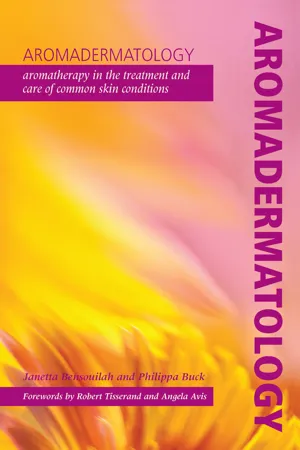
Aromadermatology
Aromatherapy in the Treatment and Care of Common Skin Conditions
- 145 pages
- English
- ePUB (mobile friendly)
- Available on iOS & Android
Aromadermatology
Aromatherapy in the Treatment and Care of Common Skin Conditions
About This Book
This comprehensive, evidence-based guide promotes an integrative approach to using complementary therapies with conventional medicines.
It increases awareness of the sound scientific basis to aromatherapy with a wealth of data, and contains practical information for treatment.
Contents include: Skin structure and function * Essential oil sciences in context * Aromadermatology and safety issues * The essentials of aromatic formulations * Skin-care essentials * Skin and the psyche * Skin infections * Childhood skin complaints * Inflammatory disorders * Wound care * Nails, hair and sebaceous glands
'With the growing interest in aromatherapy, it is important that therapists and healthcare professionals are able to offer a valid rationale when integrating essential oils into clinical care. Sound knowledge of bio-chemical principles and the ability to critically appraise and apply relevant research are fundamental requirements. This book offers a comprehensive, in-depth view of current knowledge. The authors have skilfully woven research and clinical application. A range of therapeutic possibilities is explored and offers practitioners alternative approaches to the management of skin conditions. These include detailed discussions on different methods of application. I hope that this book will become a standard text on both pre-qualifying and CPD courses in aromatherapy.' – Angela Avis, in her Foreword
'This well-illustrated, thorough and authoritative text is written in a language and style that is clear and accessible to a variety of healthcare practitioners. A thorough understanding of dermatology underpins the book, and both current research and clinical knowledge are elegantly applied to the skin conditions discussed.' – Robert Tisserand, in his Foreword
Frequently asked questions
Information
Chapter 1
Skin structure and function
Introduction

Skin layer | Description |
|---|---|
Epidermis | The external layer mainly composed of layers of keratinocytes but also containing melanocytes, Langerhans cells and Merkel cells. |
Basement membrane | The multilayered structure forming the dermoepidermal junction. |
Dermis | The area of supportive connective tissue between the epidermis and the underlying subcutis: contains sweat glands, hair roots, nervous cells and fibres, blood and lymph vessels. |
Subcutis | The layer of loose connective tissue and fat beneath the dermis. |
Skin anatomy
Epidermis
- stratum basale (basal or germinativum cell layer)
- stratum spinosum (spinous or prickle cell layer)
- stratum granulosum (granular cell layer)
- stratum corneum (horny layer).

Stratum basale
Stratum spinosum
Stratum granulosum
Stratum corneum
Dermoepidermal junction/basement membrane
Dermis
- a thin papillary layer
- a thicker reticular layer.
Table of contents
- Cover
- Title Page
- Copyright Page
- Table of Contents
- Forewords
- Preface
- About the authors
- Acknowledgements
- Botanical terminology
- List of abbreviations
- 1 Skin structure and function
- 2 Essential oil sciences in context
- 3 Aromadermatology and safety issues
- 4 The essentials of aromatic formulations
- 5 Skin-care essentials
- 6 Skin and the psyche
- 7 Skin infections
- 8 Childhood skin complaints
- 9 Inflammatory disorders
- 10 Wound care
- 11 Nails, hair and sebaceous glands
- Glossary
- Appendix
- Some voluntary organisations and support groups
- Index